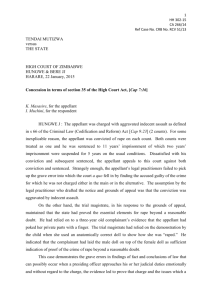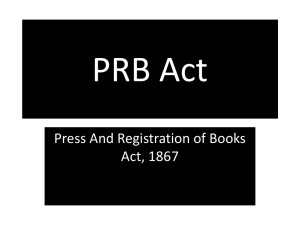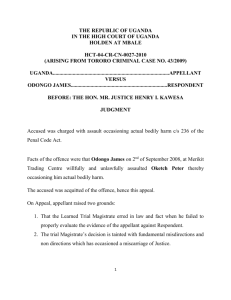hc-anti-corruption-division-2015-8
advertisement
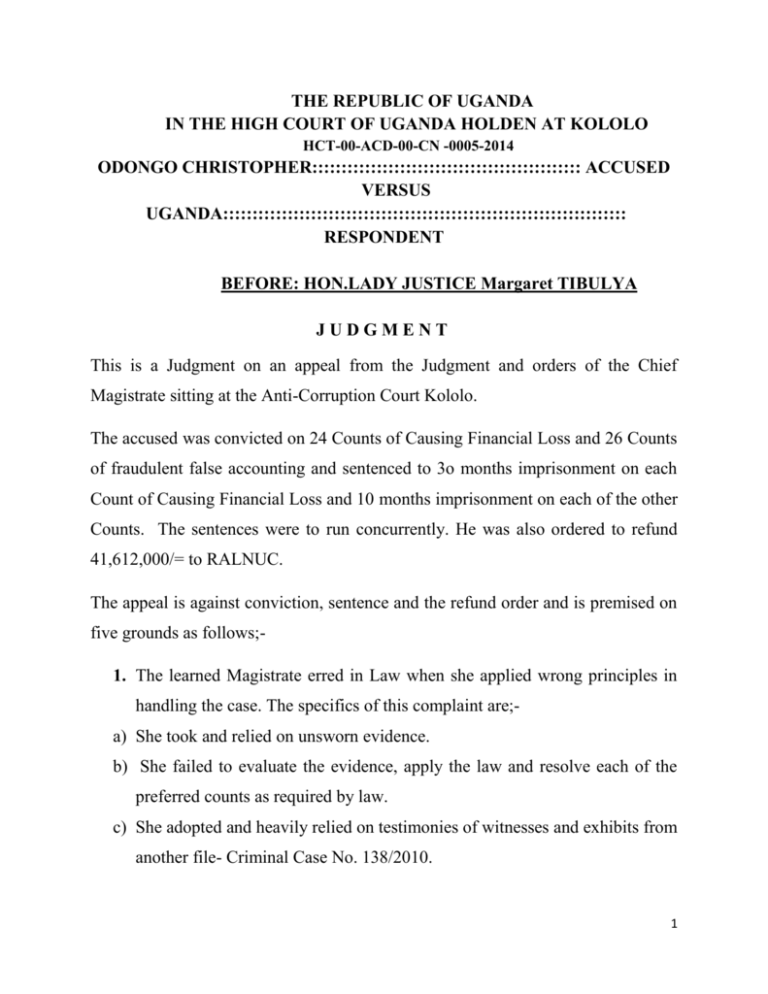
THE REPUBLIC OF UGANDA IN THE HIGH COURT OF UGANDA HOLDEN AT KOLOLO HCT-00-ACD-00-CN -0005-2014 ODONGO CHRISTOPHER:::::::::::::::::::::::::::::::::::::::::::::: ACCUSED VERSUS UGANDA::::::::::::::::::::::::::::::::::::::::::::::::::::::::::::::::::::: RESPONDENT BEFORE: HON.LADY JUSTICE Margaret TIBULYA JUDGMENT This is a Judgment on an appeal from the Judgment and orders of the Chief Magistrate sitting at the Anti-Corruption Court Kololo. The accused was convicted on 24 Counts of Causing Financial Loss and 26 Counts of fraudulent false accounting and sentenced to 3o months imprisonment on each Count of Causing Financial Loss and 10 months imprisonment on each of the other Counts. The sentences were to run concurrently. He was also ordered to refund 41,612,000/= to RALNUC. The appeal is against conviction, sentence and the refund order and is premised on five grounds as follows;1. The learned Magistrate erred in Law when she applied wrong principles in handling the case. The specifics of this complaint are;a) She took and relied on unsworn evidence. b) She failed to evaluate the evidence, apply the law and resolve each of the preferred counts as required by law. c) She adopted and heavily relied on testimonies of witnesses and exhibits from another file- Criminal Case No. 138/2010. 1 d) Wrongly admitted in evidence and heavily relied on prosecution exhibits 326 which were illegally and / or wrongly tendered in evidence by virtue of PW21’s testimony. e) Heavily relied on the non-existent testimony of the appellant; 2. She erred in law and fact when she wrongly held that the prosecution had proved all the ingredients of the charges of fraudulent false accounting and causing financial loss in all Counts and therefore wrongly convicted the appellant. 3. She erred in law and fact when she heavily relied on the audit report (exhibit P.2) which was based on instructions that were at variance with the RALNUC’S program manual and thus arrived at the wrong conclusion in convicting the appellant. 4. She erred in law and fact when she disregarded major contradictions and inconsistencies in prosecution evidence and therefore arrived at the wrong conclusion in convicting the appellant. 5. She erred in law and fact when she ignored evidence of other payments made and therefore wrongly ordered the appellant to refund UGX 41,612,000/= to RALNUC. The brief facts of the case are that the accused was an employee of RALNUC (Restoration of Agricultural livelihoods in Northern Uganda Component) , a project under the Agricultural sector programme support- Danida). He was working as an Advisor in the project. His roles included making payments to service providers and preparing accountabilities. During the period in issue RALNUC conducted several trainings for members of the public in the project areas. It is in evidence that the trainings were conducted at the sub-counties and that they were one day non-residential activities, where only lunch was provided to 2 the participants. The participants were given a 1,000/= transport refund at the end of the each day. The accused however rendered accountabilities indicating that the participants had been accommodated in Hotels and that they had meals from those hotels (exhibits P.3-P26). The prosecution maintains that the only meal that was provided to the participants was lunch. The food was prepared and served at the training venues by locally sourced service providers. Most of the hotels reflected in the exhibits either does not exist. The two or three that exist did not have dealings relating to lesser amounts of money than portrayed in the accountabilities. The trainings were one day activities- participants were not accommodated in hotels. They were given transport refund ranging from 1,000/= to 5,000/= for most of them and up to 20,000/= for the local leaders. The defence requested that the evidence that had been given by Ogwal Joseph, Silus Katonyera and Betty Okello in Criminal Case 138/2010 be applied in this case. The Court ruled that their evidence had been “adopted” to this case. The gist of their evidence was that in keeping with RALNUC policy, vulnerable persons provided hotel services to the participants. The vulnerable persons are the hotels, restaurants, lodges, Inns named in the accountability documents. Those institutions are small eating places which did not accommodate the participants. The money for accommodation was given to the participants; They signed for it in a cash register. Further that PW21 (Niels) had a grudge against the accused over his job. Katonyera however said that( Niels(PW21) was not working under the accused- that they were at the same level. Betty Okello said that she is the chair person of Odworo women’s group which provided hotel 3 services to the participants. The group was paid 50% advance, as Odworo international hotel. She signed for the money in a cash register and the balance of 3,900,000/= was signed for in a voucher exhibit P63 on 8/7/2006. The accused did not give evidence though he had said he would give sworn evidence. This being the first appellant court, it has to consider and give the evidence a fresh evaluation and arrive at its own conclusion, bearing in mind the fact that it never saw the witness testify;- NSIBAMBI Vs LUVINSA NANKYA (1980) HCB 81. GROUND 1 (a) – (e) a) That the Magistrate took and relied on the unsworn testimony of prosecution witnesses. For the appellant it was argued S.101 (1) of the Magistrates’ Courts Act requires that witnesses should give evidence on oath but that this was not done. S.101 (1) of the Magistrate Courts Act provides that; “Every witness in a criminal case or matter in a Magistrate’s court shall be examined upon oath and the court before which any witness shall appear shall have full power and authority to administer the usual oath.” The back ground to the issue is that the accused was answering related charges in case file 138/2010. The complaints in this case file (139/2010) arose from similar facts and circumstances as those in case 138/2010. Because of that the two cases shared the same witnesses. Moreover, they were tried by the same Magistrate at around the same time. Some witnesses testified in both files on the same day. 4 Such witnesses were only reminded of the oath they had taken in the previous file before they gave evidence in the next file. The appellant argues that those witnesses should have taken fresh oaths because the allegations against the accused in the two case files were separate. The purpose of taking an oath is to have the witness reminded of the duty of telling the truth. In this case the oaths of which the witnesses were reminded had been taken in a space of time ranging from mere hours to three months. These oaths had been taken in the presence of the same Magistrate, prosecutions, advocate and accused person. Section 101 (1) Magistrate’s courts Act does not go as far as prescribing that the oath should be taken immediately before the testimony. The taking of an oath is not a merely procedural or symbolic routine. An oath is a serious matter, the taking of which should be for purposes of reminding witnesses of the duty of telling the truth. What is important is the fact that the witness is aware that they are under oath. This suffices for purposes of S 101(1) Magistrate’s courts Act. In this case the witnesses were reminded of the oath they had taken. There is no indication that they did not understand or remember that they were under oath. There is no indication that they told lies by reason of the procedure adopted. The accused could not have been prejudiced at all. But just in case I am wrong and the Magistrate acted in error, it is true that not every error will result in a miscarriage of justice- FANJOY Vs THE QUEEN 19822 SCR 233. Since there is no indication that there was miscarriage of Justice, the error if any cannot be the basis of rejecting the evidence of the affected witnesses. My ruling however is that the witnesses took oath. Ground 1(a) therefore fails. 5 1(b) The Magistrate failed to evaluate the evidence, apply the law and resolve each of the preferred counts as required by law. The relevant law is Section 136(1) of the Magistrate’s courts Act which provides that “Every Judgment…… shall contain the point or points for determination, the decision thereon and the reason for the decision”. Having perused the lower court Judgment, I did not find any factual basis for impugning it. The ingredients of the offences and findings on those ingredients were laid out in the Judgment. Ground 1(b) therefore fails. Part of the appellant’s complaint was that the conviction was omnibus in the sense that the evidence was not evaluated count by count. The law, however, does not prescribe a particular style of Judgment writing beyond the guidance given in Section 136 of the Magistrate’s courts Act. The indictment in this case is comprised of a total of 78 counts. The convictions were on all counts of causing financial loss and fraudulent false accounting; meaning that the questions for court’s consideration fell in only two categories. One of those issues was cross cutting the employment status of the accused. This could be answered in one sentence for all counts. Repeating the same answer 78 times would have resulted in poor Judgment craftsmanship. The only issue that needed to be resolved for each separate count related to the loss of the specified monies in each count. This the learned Magistrate did by relating the exhibited accountability documents to each count. She for example found that 6 counts 33 and 37 were not proved because there were no accountability documents evidencing the loss of the specified monies in those counts. She also found that count 37 was a replication of count 35. The Magistrate considered the evidence and found the relevant counts proved. The style of writing she opted for was within her prerogative. A fresh evaluation of the evidence leads to the same conclusion; - a conviction on the counts the appellant was convicted on. CAUSING FINANCIAL LOSS It was common cause that the appellant was an employee of RALNUC, a public body. There is abundant evidence that the appellant authorized the impugned payments. PW7 (Namirembe) was clear on this. The defence did not contest, in fact they admitted that the payee institutions did not exist- DW2 (Katonyera) was clear on this. It is in evidence that the services alleged to have been provided by the so called hotels were not provided by them and yet there were invoices and receipts acknowledging payment of the monies to those institutions. The accused by authorizing payment to fictitious institutions knew or had reasons to believe that it would cause financial loss and loss was occasioned to RALNUC. FRAUDLENT FALSE ACCOUNTING In R V.WINES (1953)2 AER the word “defraud” was defined as; “ by deceit to induce a course of action”. 7 The accused made, was privy and / or authorized the making of false entries in payment vouchers (P.3 – P26). He induced or intended to induce release of more funds to him. There was evidence sufficient to ground the convictions for fraudulent false accounting. GROUND 1(c) Adoption and reliance on witness testimonies and exhibits from case file 138/2010 Because of the connectivity between case file 138/2010 and 139/2010, both the prosecution and defence at some stage asked court to accept the evidence of witnesses who had testified in case No. 138/2010 and which evidence was on case file 139/2010, for purposes of case file 139/2010. The process was code named “a adoption of evidence”. In all instances were applications for adoption were made they were allowed without objection. The defence itself applied that the court adopts the cross-examination of PW19 ( Ephraim Kioi) and it was granted. They also successfully applied to have the entire defence evidence adopted. For the appellant to turn around and complain is tantamount to having his cake and eating it. Moreover, a look at the evidence that was allowed in this manner convinces me that no prejudice was suffered by the appellant. The aspects of PW4’s (Roberts Okwirs) evidence that were adopted for example only relate to the fact that he 8 knew the accused. Even without that adopted evidence, Okwirs evidence remains intact and adverse to the appellant. PW19 (Ephraim Kioi) testified in Chief. It is only the cross examination and reexamination that were adopted. The defence could not have been forced by the court to cross examine a witness- that is not court’s obligation. The appellant was represented by counsel. The decisions he took were therefore informed. Most important however is the fact that no law was violated by the procedure that was adopted by the court. If the record of evidence in case file 138/2010 were to be taken as having been exhibits, the law relating to their admissibility was not violated. If we turn to trial procedural laws in the Magistrate’s courts Act, S 137 and 1378 of the Magistrate’s courts Act were not violated. The evidence that was adopted had been taken in the presence of the accused in case file 138/2010 and when it was adopted, it was still in his presence. Secondly, that evidence was taken down in writing in the language of the court. It was in addition sworn evidence in keeping with Section 101 (1) Magistrate’s courts Act. Having allowed the evidence on record, reliance on it was proper it was part of the record of proceedings. Exhibit P.4 was received on court record without objection from counsel. It was not merely “adopted” as the appellant suggests. The fact that it was an exhibit in case 138/2010 does not bar its use as an exhibit in case 139/2010. The complaint about adoption of evidence from case file No. 138/2010 fails. 9 GROUND 1(d) The Magistrate wrongly admitted in evidence and heavily relied on prosecution exhibits. P3-P26 which were illegally and or wrongly tendered in evidence by virtue of PW21’s testimony. The argument here is that PW21 (Neils) who was not the author of the documents could not tender them in without violating the admissibility laws. PW21’s evidence was that he received the documents in the ordinary course of his business. The prosecution did not tender the documents through him as the author, but by virtue of his work. This fact distinguishes this case from MYERS V DPP (1964)2 (AER) and TENYWA V UGANDA (1967)E .A (102) which counsel for the appellant cited. In this regard, S.30 (b) and (c) of the evidence Act are instructive. GROUND 1(e) The learned Magistrate heavily relied on the non-existent testimony of the appellant. The court record bears a record of the accused saying that he would give sworn evidence which he did not. The omission to give evidence was an informed decision since counsel for the accused is on record as having closed their case voluntarily. 10 The Magistrate however erroneously made reference to the accused’s evidence in defence in case No. 138/2010- obviously under mistaken belief that, that evidence had been “adopted” from case No. 139/2010. While I agree that the Magistrate errered in that regard, I do not think that the exclusion of the accused’s evidence would have made a difference. I have already found that there is sufficient evidence (without the accused’s evidence to prove that he caused financial loss and that e rendered fraudulent accountabilities while the complainant is valid, it does not change the finding. GROUND 2 That the learned Magistrate erred when she found that the prosecution had proved all the ingredients of the offences. Counsel for the appellant argued that the Magistrate made omnibus findings which violated S.136 (1) and (2) of the Magistrate’s courts Act). I have already said that S.136 does not prescribe a style of Judgment writing. I also found that there was sufficient evidence to ground a conviction on all the relevant counts. This ground also fails. GROUND 3 That the Magistrate erred in law and fact when she heavily relied on the Audit Report (exhibit P.2) which was based on instructions that were at variance with the RALNUCS program manual. Without going into details, I will only say that a policy that compounds or covers up crime would be contrary to public policy and therefore illegal. I do not believe that RALNUC operated such a policy. In this case there is evidence of crime. No 11 policy could bar investigation and prosecution of an offender. This is regardless of how when and who the investigator is. Other issues raised by the appellant are;a) That PW14 (Peter Ejang) by saying that he did not see where he signed for the 1,000/=. ( see pg 32, line 7 from down) proves that some attendance lists were forged. The witness identified his name in the attendance list. Therefore there is no basis for the appellant’s argument. b) That the participants were given money for accommodation though the training was non-residential. This argument only re-affirms the state case against the accused. The accountability documents bear names of hotels and individual participants as payees. The appellants paying cash to individuals was in line with the RALNUC programme guidelines. There is no evidence that the money in issue was paid to individuals. The payees were hotels which on evidence are nonexistent. There was no loss to RALNUC because what the accused did was envisaged by the programme expenditure and modus operandi. There was loss to RALNUC because payments were made to nonexistent entities which did not render any services to RALNUC. Some documents ( invoices, receipts and cash registers) which could have exonerated the accused were not brought to court. 12 There is evidence that the exhibited documents were all that there could be, they comprised of vouchers, invoices and receipts. Cash registers could have never existed. Further the evidence of PW19 (Neils) to who the accountabilities were rendered was that the exhibited documents were all that there could be. Ground 3 therefore fails. Grounds 4 and 5 That the trail Magistrate disregarded major contradictions and inconsistencies in the prosecution evidence. Also that she ignored evidence of other payments that were made. I do not think there were any contradictions as the appellant argues. The different participants were testifying to how much they were paid. Some participants were clear that they were paid slightly more money because they were local leaders. More important, though there had been contradictions and inconsistencies as to how much each participants got, it would be of no consequence. This is because the prosecution case relates to amounts paid to hotels and not to participants. The complaint that the monies received by the various witnesses should have been deducted from the refundable amount is without merit. The money received by those witnesses is not related to that paid to the fictitious hotels. In fact the deductions made by the learned Magistrate were made in error, which is to be corrected. The monies paid out to the fictitious hotels as reflected in the exhibited vouchers total to 67,145,500/= and should not be mixed with payments to individuals. Counsel’s argument is without merit. 13 Other issues 1. There were no women groups in this scam. Factitious hotels, restaurants and Inns were the payees. 2. The learned Magistrate found that there was no grudge between PW21 (Neils) and the appellant. She was right. PW21 was involved in the audit in the course of his ordinary business. There is abundant evidence incriminating the accused. 3. On the whole there is no merit in the appeal. The Judgment and orders of the lower court are upheld. Except that the accused should refund a total of 67,145,500/= instead of the 41,612,000/= that he had been ordered to refund by the lower court. It is so ordered. …………………………… HON.LADY JUSTICE MARGARET TIBULYA JUDGE OF THE HIGH COURT. 15/5/2015 14
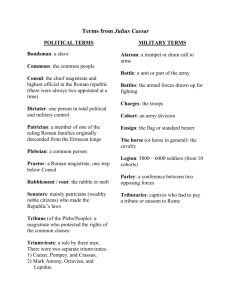
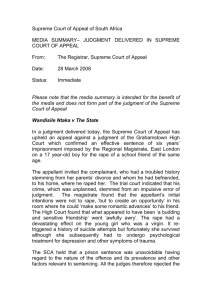
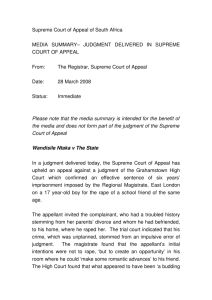
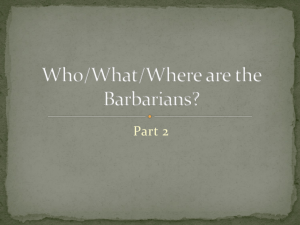
![[J-56A&B-2014][MO – Eakin, J.] IN THE SUPREME COURT OF](http://s3.studylib.net/store/data/008438149_1-ddd67f54580e54c004e3a347786df2e1-300x300.png)
